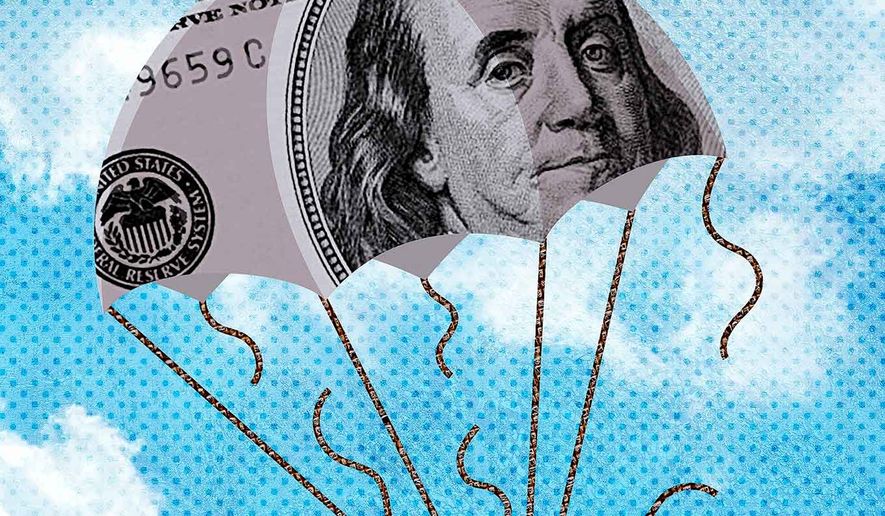OPINION:
Federal Reserve Chairman Jerome Powell is poised for a soft landing. Recently, he testified that the central bank may soon be able to cut interest rates.
This optimism reflects the consensus among economic forecasters — the most recent Wall Street Journal survey has growth in gross domestic product slowing to about 1% in the first three quarters of this year and inflation to less than 2% by 2025.
The financial press is lionizing Fed Gov. Christopher Waller, who has long believed that a soft landing is likely, as well as proselytizing bank economists that enjoy privileged access to Mr. Powell.
Slow growth but no recession and inflation below 2% — that’s a soft landing. But not so fast: This column isn’t convinced that the trade-off between growth and inflation has become so benign or the economy so predictable.
As we entered 2023, the majority of forecasters were screaming that the economy was at risk of recession, GDP growth scored 2.5% and unemployment stayed below 4%.
Just weeks before the fourth-quarter 2023 GDP figures were published — and most of the data needed to compute that figure was in hand — the Journal panel of forecasters predicted growth at 1.8%.
It came in at 3.2% — a 78% error!
How did all those Ph.D.s get it so wrong? And can Mr. Powell’s Team Transitory recast as Team Soft Landing be trusted?
The answer is we don’t know what growth and inflation will do next, and Mr. Powell’s confidence about an imminent rate cut sets the economy up for a calamity.
On his words, markets are anticipating a rate cut in June. If events force him to walk back those words, as he did when inflation proved anything but transitory, stocks could tank and pull a weakening economy into a downward spiral.
The problem is the recent recession was like no other. Like COVID, it escaped from a lab.
This was the only time in modern history that the U.S. and foreign governments put their economies to sleep and borrowed to offer massive relief payments to tide over businesses and workers.
Households had few places to spend that money, and much of it was saved. For many, that extra purchasing power has only recently run out.
Consumer spending is the primary driver of growth, but after those extra savings were gone, households could turn to credit cards that were underused during the shutdown.
Interest payments on consumer debt are now as large as mortgage payments, but overall household debt is still low by historical standards. Loan delinquencies, though ticking up, are still below pre-COVID levels.
If they are so disposed, households can keep on spending, but they still don’t have enough places to spend their money. That drives prices up.
For example, Americans are spending more than ever in restaurants and on fast food, but last year, about 4,600 more independent restaurants closed than opened.
Restaurants are turning away groups larger than four. Menu prices are up 4.6% in the last year and 31% since 2019.
Amid spendthrift governments and minimum wage campaigns, local prosecutors going easy on nonviolent crime have taxed the bottom lines of restaurants since the murder of George Floyd.
In Denver, Chef Zorba’s restaurant has had to cope with a 60% increase in real estate taxes, annual increases in entry wages, and thieves taking its propane tanks, outdoor heaters, a storage shed and racks chained together outside.
Across the economy, labor remains tight and progressive governors and mayors are finally acknowledging they have a problem even if the liberal media are in denial. Crimes show up in statistics only if they get reported. But when businesses and individuals see no results, they don’t bother to call.
The Fed most closely monitors the personal consumption price index.
For the most recent month available, January, the annualized pace of price increases was 4.2%, but that’s being pulled down by manufactured imports from China, where deflation reigns in a sick economy.
For core services, which strips out the volatile energy sector, prices were up 7.1%.
With 1.4 jobs advertised for every unemployed job-seeker, the labor market remains tight, and the posture of monetary policy is far from restrictive.
The Fed is operating on the assumption that the inflation-adjusted rate of interest that would not encourage accelerated growth or increase inflation is about 0.5%. But we have good reason to believe it has risen to about 2%.
Mortgages, corporate bonds and other long-term credit tend to price off the 10-year Treasury rate, and that’s running just a bit above 4% — making the real rate of interest about zero and the posture of monetary policy quite lax.
With inflation raging in the services sector, Mr. Powell is irresponsible or at least terribly misinformed to be talking about rate cuts anytime soon.
A soft landing is anything but certain.
• Peter Morici is an economist and emeritus business professor at the University of Maryland, and a national columnist.




Please read our comment policy before commenting.